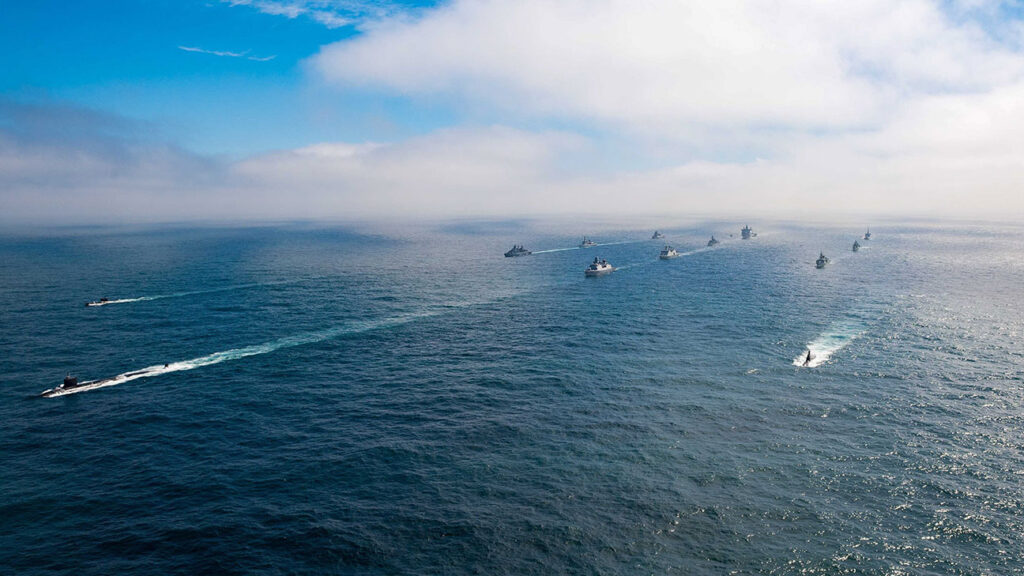Ships and submarines from Canada, France, Germany, the Netherlands, Norway, Portugal, the United Kingdom and the United States sail together during Exercise Dynamic Mongoose 2022 on June 19, 2022. NATO ALLIED MARITIME COMMAND
THE WATCH STAFF
A flotilla of surface ships and submarines, as well as maritime helicopters, gathered in and around the waters of Iceland in late April for the start of NATO’s annual anti-submarine warfare exercise, Dynamic Mongoose. The vessels and aircraft alternated as hunter and hunted to test the military alliance’s warfare capabilities and trans-Atlantic cooperation.
Dynamic Mongoose prepares NATO maritime forces to respond and adapt to any type of threat, from seabed to space. It trains submarine crews to evade and respond from deep below the surface, while simultaneously teaching crews aboard surface vessels and aircraft how to detect subs and address the threat they pose. Nine nations participated in the 12-day exercise.
Forces from Canada, Denmark, Germany, Iceland, the Netherlands, Norway, Poland, the United Kingdom and the United States conducted a series of real-time scenarios focused on detecting, tracking and engaging submarines in an environment with multiple threats. The exercise was set in the expanse of water known as the Greenland-Iceland-United Kingdom-Norway (GIUK-N) gap. The frigid conditions present their own challenges for NATO forces.
“Dynamic Mongoose is an extremely important anti-submarine exercise in the High North which provides an excellent opportunity for NATO allied nations to train together and build upon our already impressive interoperable capabilities,” said Royal Navy Capt. Steven McAllister, assistant chief of staff, submarines, at NATO Allied Maritime Command. “The GIUK gap is a critical maritime crossroad that NATO Allied Maritime Command will exercise in to ensure freedom of action in the region whilst maintaining our levels of readiness and sustaining values-based security across the seas.”
Iceland was this year’s host nation. The Icelandic patrol ship Freyja and the Icelandic Coast Guard helicopter squadron participated, and Iceland provided facilities, food and accommodation in the Keflavík security area.
Marvin Ingólfsson, deputy director of the Icelandic Coast Guard’s Defense Department, told RÚV, Iceland’s national public broadcasting organization, that the exercise is significant for a small country like Iceland.
“It’s always important for us to train,” Ingólfsson said. “We have the unique position of being a tiny state or micronation in the north, and the military position of the country is extremely important to all NATO member states. For us, this is always extremely important, to always be prepared and always be on our toes.”
The ability to protect sea lines of communication and monitor submarine activity remains a top NATO priority. In January, NATO announced Baltic Sentry, a mission to guard undersea communications cables in the Baltic Sea after commercial ships were accused of damaging the equipment and a gas pipeline there. Iceland, with its strategic location in the GIUK-N gap, plays a pivotal role in securing the North Atlantic.
Dynamic Mongoose 2025 challenged forces to adapt to rapid changes. Patrol aircraft supported these operations with reconnaissance, surveillance and coordinated attacks against simulated adversary submarines.
Ships from NATO Maritime Group 1 (SNMG1) took part in the exercise. “Dynamic Mongoose 2025 is a very beneficial exercise for Standing NATO Maritime Group 1,” said the SNMG1 commander, Commodore Arjen S. Warnaar. “It brings a varied array of NATO anti-submarine warfare capabilities together, and it does that in the crucial GIUK-N gap, where NATO requires an effective counter to the submarine threat. In this way, Dynamic Mongoose 2025 provides our air, surface and sub surface units a very realistic anti-submarine warfare training opportunity. An opportunity which we will put to good use.”
Georg Kr. Lárusson, director of the Icelandic Coast Guard, told RÚV that the exercise is important for Iceland and its people in times of uncertainty. “Working with our neighbors, coordinating working methods and communication methods, that is very important in these times,” he said.
In testimony before the Senate Armed Services Committee on February 13, 2025, Gen. Gregory M. Guillot, commander of U.S. Northern Command (USNORTHCOM) and the North American Aerospace Defense Command, said: “Arctic responsibilities are shared across multiple geographic and functional combatant commands, and as competition in the region increases, safeguarding Arctic access and freedom of maneuver will depend on Joint Force Arctic operational capabilities and build on the already strong ties between Arctic partners. USNORTHCOM places enormous value on the ability to conduct operations and exercises in the High North and to execute assigned missions in coordination with fellow combatant commands.”

